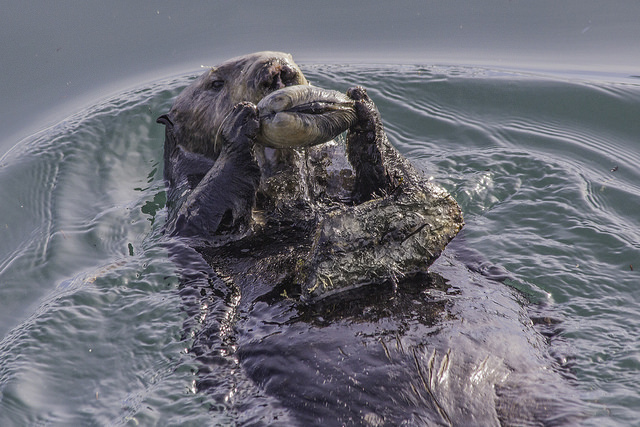Smithsonian Study Reveals Tool-Using Sea Otters Not Closely Related
Tool use by sea otters to break open well-armored food is not necessarily a family matter, according to a new study published this week by the Smithsonian Conservation Biology Institute (SCBI) and partners. Unlike previous research that has found that a group of tool-using Indio-Pacific bottlenose dolphins share a common genetic lineage, this study found that tool use in sea otters is ubiquitous and actually has little to do with genetic ties.
“Sea otters and bottleneck dolphins both use tools and they are ecologically similar, so we thought they might have a similar genetic pattern,” said Katherine Ralls, scientist emeritus at SCBI’s Center for Conservation Genomics and lead author of the paper, published March 22 in Biology Letters. “Surprisingly, what we discovered is that sea otters that most frequently use tools are no more related to each other than to the population as a whole.”
Although not all individuals in a population use tools, sea otters commonly use rocks or other hard objects to break open their meals—marine snails, crabs and abalones, for example. The paper’s authors included in the study individual otters they had observed using tools for at least 40 percent of captured prey. SCBI’s Center for Conservation Genomics analyzed the genetic information collected from individual sea otters along the California coast between 2000 and 2014.
“DNA analysis is critical to better understanding our natural world and our world’s natural history, in this case helping us get a better grasp on the little-known world of tool use in marine animals,” said Nancy Rotzel McInerney, manager of SCBI’s Center for Conservation Genomics laboratory and co-author on the paper. “Our lab specializes in obtaining large amounts of genetic information from small amounts of tissue, hair or scat samples from rare and endangered species that are difficult to capture. In this case, we were able to obtain a whole lot of information from a small sample taken when individuals were tagged for identification.”
According to the study’s authors, the difference in genetic patterns between tool-using otters and tool-using dolphins may be the result of how long each species has been using tools. While tool use in dolphins appears to have developed within the past 200 years, sea otters may have been using tools for many thousands—or even millions—of years and may therefore be more innately predisposed to do so. Researchers aim to confirm how long sea otters have been using tools by examining fossil sea otters for the kinds of physical indications of tool use seen in modern otters.
The International Union for Conservation of Nature Red List of Threatened Species classifies sea otters as endangered. Only 2,000 sea otters existed worldwide by the end of the commercial fur trade in 1911, and the population has been rebounding since, though the species still faces various threats, including attacks by sharks and oil spills.
SCBI plays a leading role in the Smithsonian’s global efforts to save wildlife species from extinction and train future generations of conservationists. SCBI spearheads research programs at its headquarters in Front Royal, Va., the Smithsonian’s National Zoo in Washington, D.C., and at field research stations and training sites worldwide. SCBI scientists tackle some of today’s most complex conservation challenges by applying and sharing what they learn about animal behavior and reproduction, ecology, genetics, migration and conservation sustainability.
SCBI’s Jesus Maldonado also co-authored this paper. Additional authors on this paper are Roderick Bashore Gagne and Holly B. Ernest, University of Wyoming; M. Tim Tinker, U.S. Geological Survey; and Jessica Fujii, Monterey Bay Aquarium.
# # #
SI-152-2017

